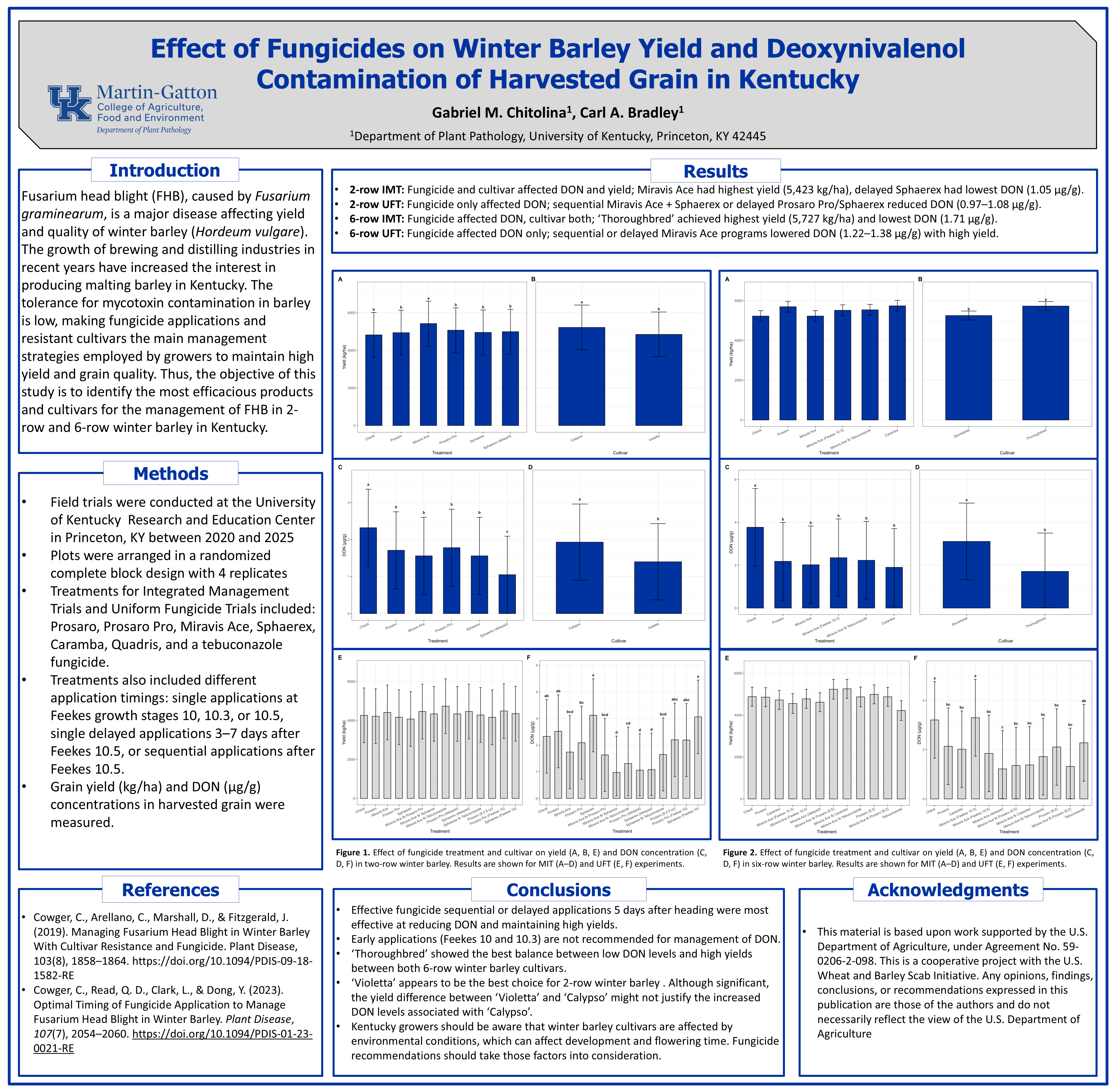Authors: Gabriel de Moraes Chitolina and Carl A. Bradley
1. University of Kentucky, Department of Plant Pathology, Princeton, KY 42445
Corresponding Author: Carl A. Bradley, carl.bradley@uky.edu
Presenting Author: Gabriel de Moraes Chitolina
Abstract
Fusarium head blight
(FHB), caused by Fusarium graminearum, is a major disease affecting
yield and quality of winter barley (Hordeum vulgare) grown in Kentucky. Field
trials were conducted in Kentucky between 2020 and 2025 to evaluate the effects
of fungicides on 2-row and 6-row winter barley cultivars for protection against
deoxynivalenol (DON) contamination of harvested grain and for impact on yield.
Integrated Management Trials (IMT) assessed fungicide products, application
timing, and cultivars (‘Calypso’ and ‘Violetta’ for 2-row barley and
‘Secretariat’ and ‘Thoroughbred’ for 6-row barley), while Uniform Fungicide
Trials (UFT) focused solely on fungicide products and application timing.
Fungicide treatments included Prosaro®, Prosaro Pro, Miravis® Ace, Sphaerex®,
Caramba®, Quadris®, and a tebuconazole fungicide, applied as single applications
at Feekes growth stages 10, 10.3, or 10.5, single delayed applications 3–7 days
after Feekes 10.5, or sequential applications after Feekes 10.5. Grain yield
(kg/ha) at harvest and DON concentration (µg/g) in harvested grain were
measured. Each trial was analyzed separately in SAS using PROC GLIMMIX.
Fungicide treatment was a fixed effect, and year and replicate (nested within
year) as random effects. In 2-row IMTs, fungicide and cultivar significantly
affected DON and yield. Results from IMTs showed Miravis Ace produced the
highest yield (5,423 kg/ha), while delayed Sphaerex 3 -7 days after Feekes 10.5
resulted in the lowest DON (1.05 µg/g). The cultivar ‘Calypso’ achieved the
highest yield (5,219 kg/ha), where ‘Violetta’ had the lowest DON (1.40 µg/g).
In 2-row UFTs, fungicide significantly affected DON but not yield. Sequential
applications of Miravis Ace followed by Sphaerex, or delayed applications of Prosaro
Pro or Sphaerex were most effective at reducing DON (0.97-1.08 µg/g), with
Miravis Ace followed by tebuconazole attaining the highest yield (4,731 kg/ha).
In 6-row IMTs, fungicide significantly affected DON but not yield, while
cultivar significantly affected both yield and DON. IMT trials showed
‘Thoroughbred’ had the highest yield (5,727 kg/ha) and lowest DON (1.71 µg/g),
and a single application of Caramba at Feekes 10.5 resulted in the lowest DON (1.90
µg/g). In the 6-row UFTs, fungicide significantly affected DON but not yield.
Sequential applications of Miravis Ace followed by Prosaro or Caramba, and
delayed Miravis Ace 3–7 days after Feekes 10.5, were most effective at reducing
DON (1.22-1.38 µg/g), while maintaining high yields (4,616-5,257 kg/ha). This
study provides insights into FHB management in Kentucky and can inform future
integrated disease management practices for winter barley growers.

